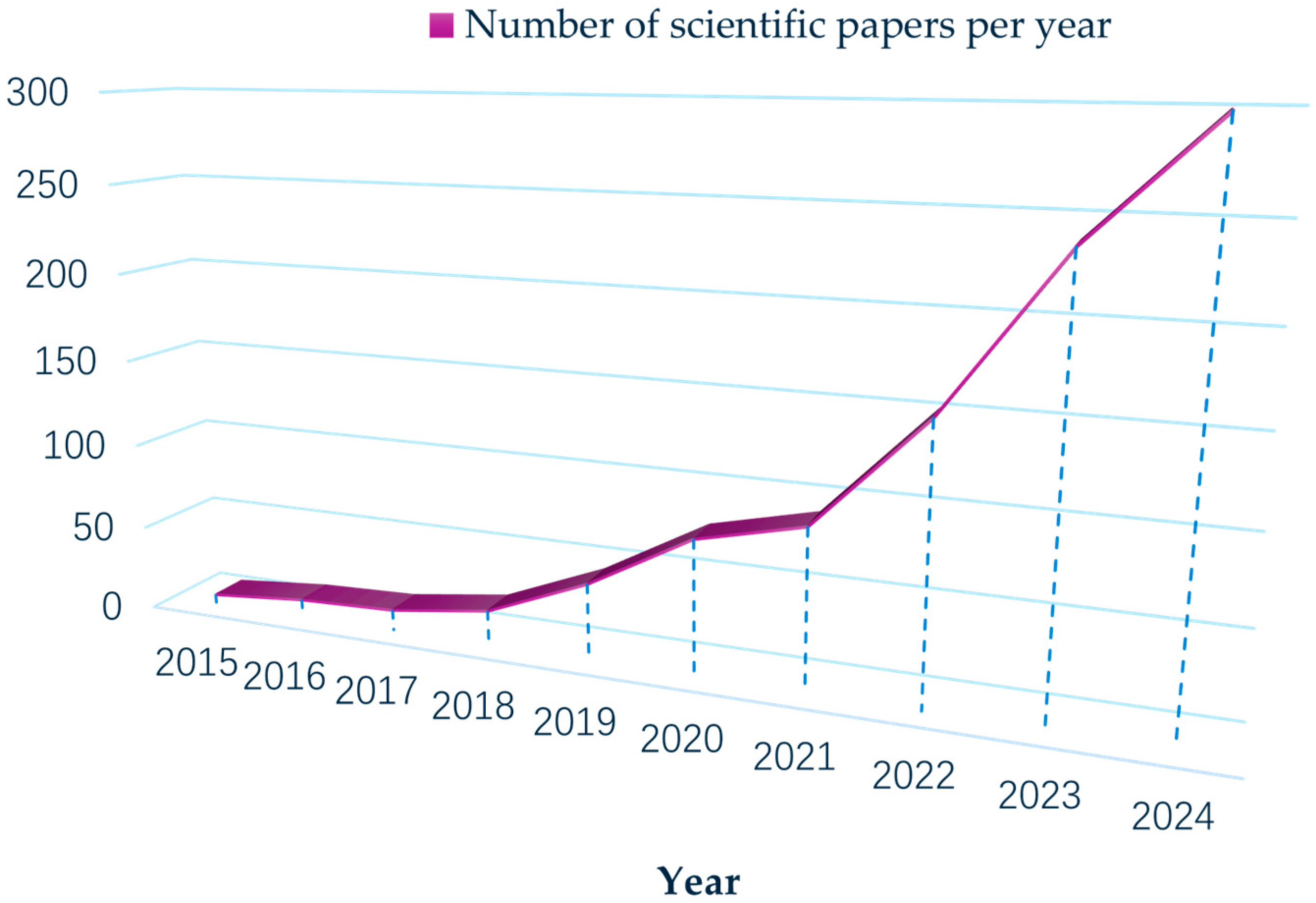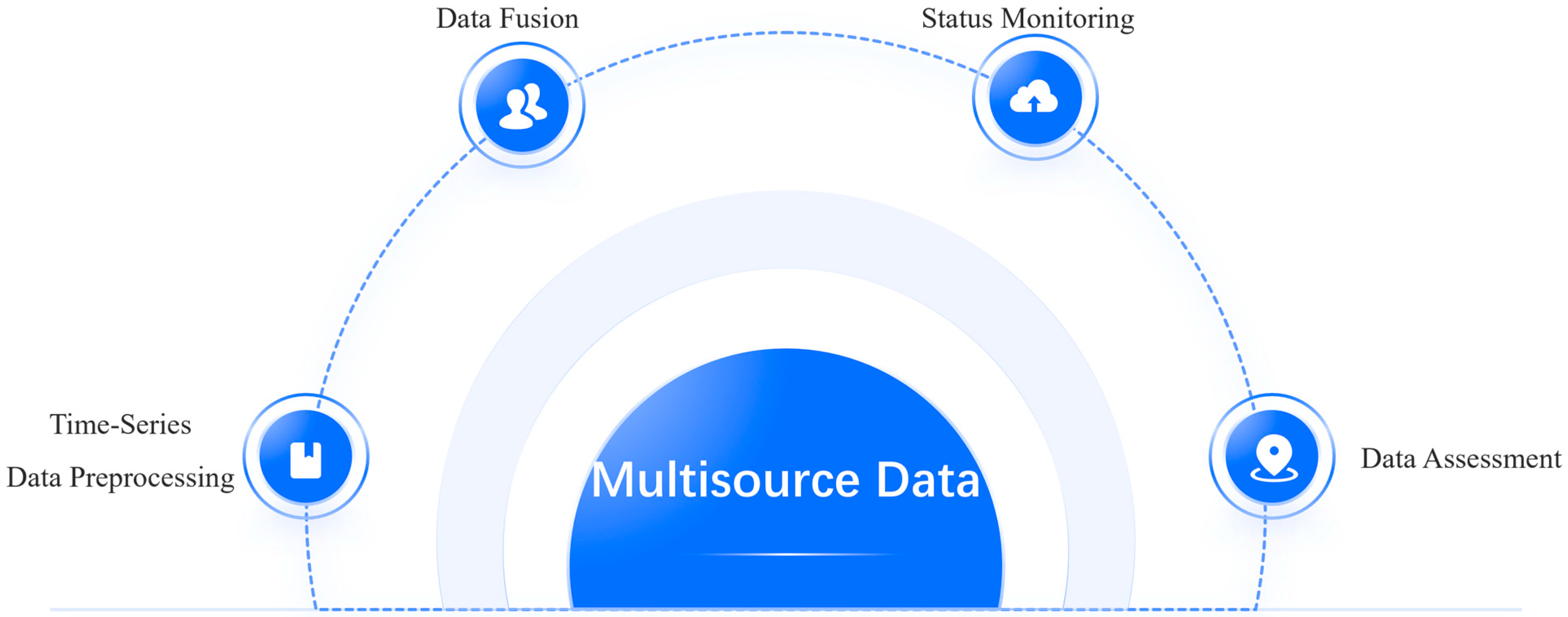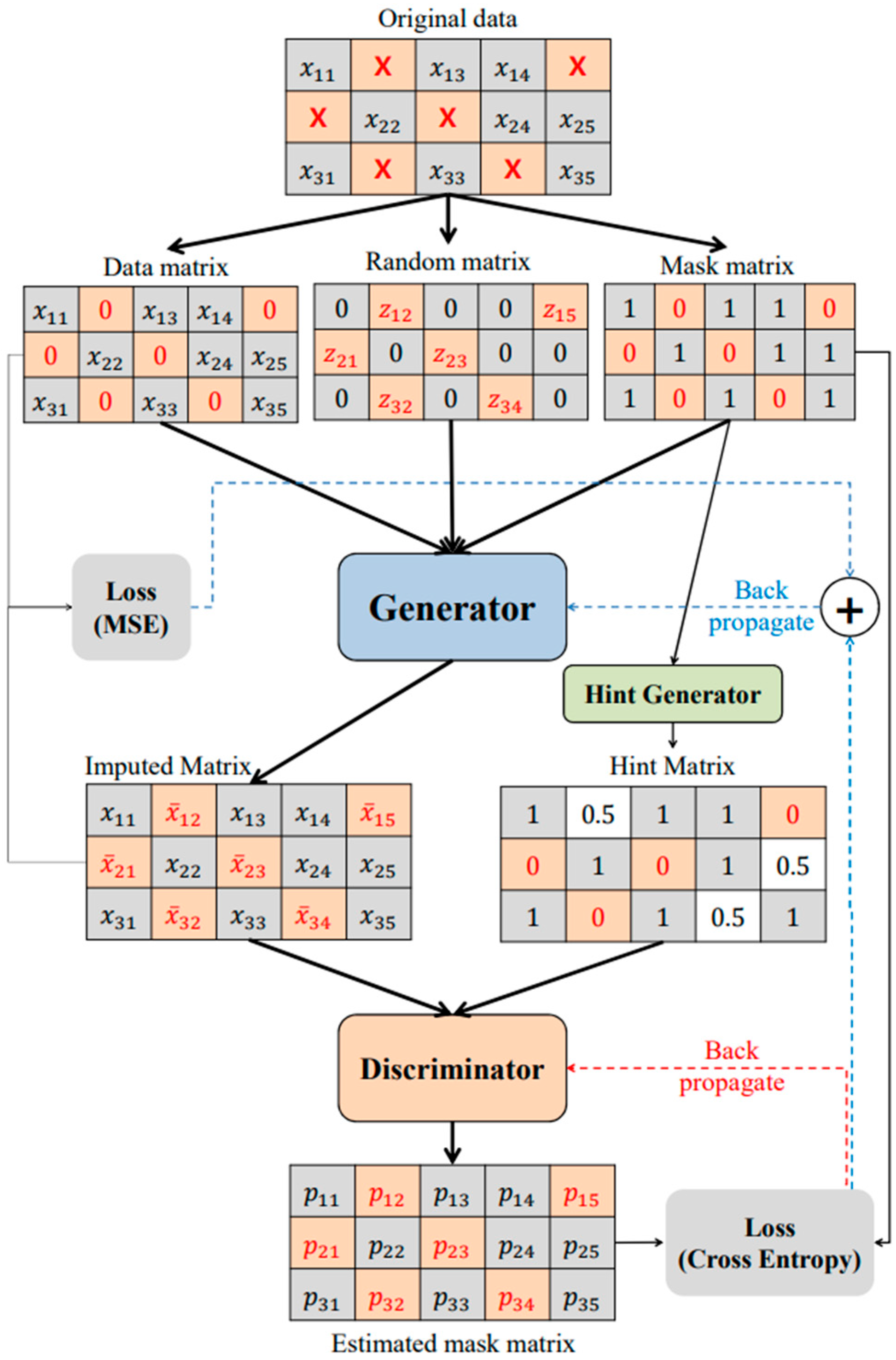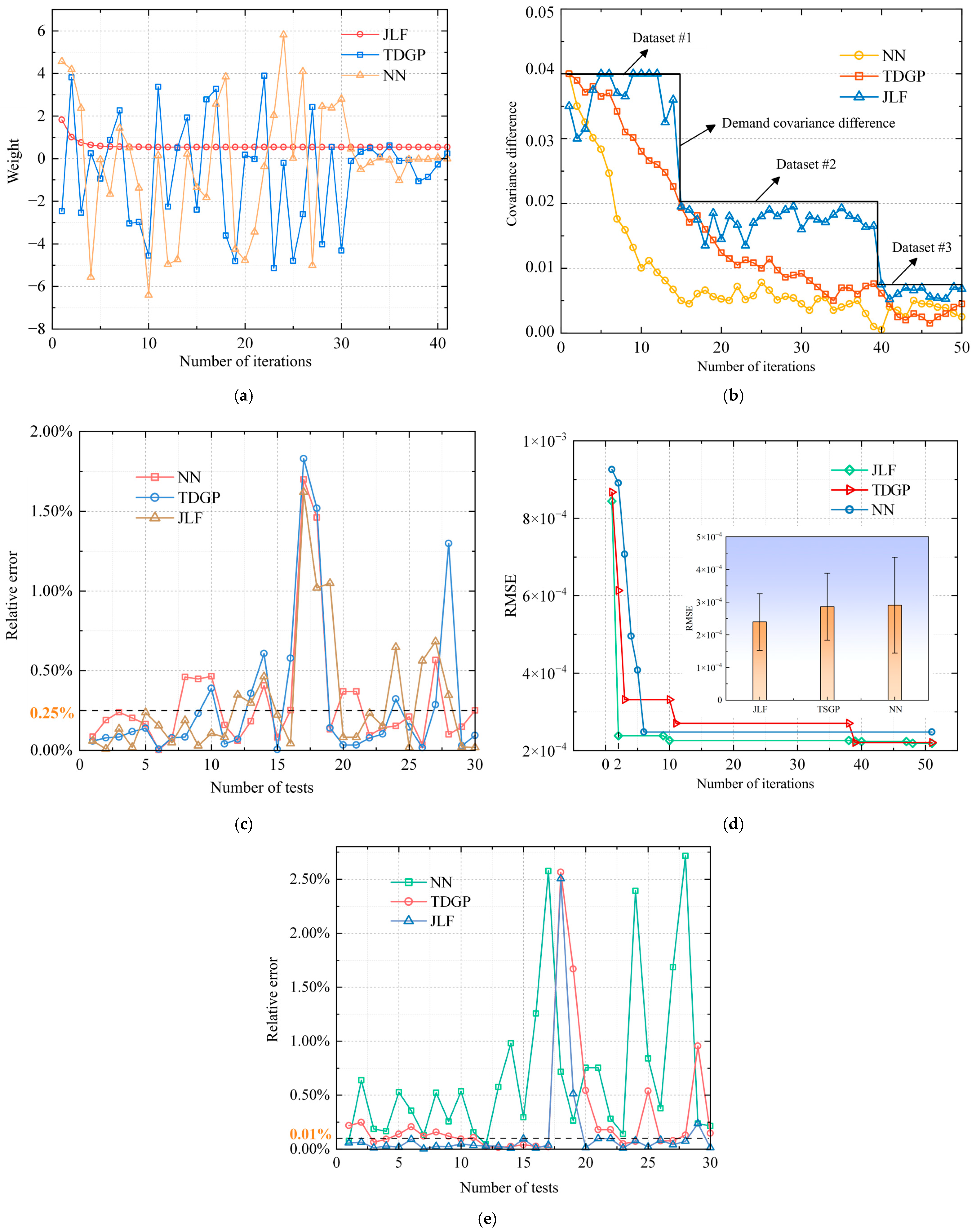Multisource Heterogeneous Sensor Processing Meets Distribution Networks: Brief Review and Potential Directions
Abstract
1. Introduction
2. Multisource Data for Distribution Networks
- (1)
- Data noise: Measurement anomalies may be caused by MSH sensor errors, electromagnetic interference, communication packet loss, etc. Due to signal pollution from multiple links and inherent nonlinear characteristics of sensors, measurement errors may also accumulate. These interference sources overlap with each other on the MSH signal transmission chains, and then form composite noise pollution that seriously distorts the true electrical characteristics.
- (2)
- Data loss: Local data loss may be induced by offline devices, communication interruption, or storage failure. Originating from both MSH sensor abnormalities and communication failures, offline devices will create data source interruption, while storage media defects lead to historical data corruption. Its spatiotemporal distribution exhibits dynamic correlation characteristics; simultaneously, in the temporal dimension, it often presents strong correlation with MSH equipment maintenance cycles and abnormal occurrence periods.
- (3)
- Data redundancy: This refers to repetitive collection of MSH data or periodic redundancy in time series. The periodic operation mode of massive DNs leads to repetitive features in the time dimension defined as temporal sequences, while similar measurement data of strongly correlated electrical nodes form spatial redundancy. This architectural redundancy not only occupies storage resources, but also causes feature confusion during MSH data analysis, which results in key information being diluted by a large amount of duplicate data.
- (4)
- Inconsistent data: Time stamps from different MSH systems are not synchronized or have conflicting dimensions. The essence of this stems from a possible lack of MSH system standardization, incomplete clock synchronization of each monitoring unit leading to time reference drift, MSH sensor-design differences causing physical quantity conversion errors, semantic ambiguity of data labels causing cross-system parsing deviations, etc.
- (5)
- High-dimensional complexity: It is challenging to analyze the correlation of massive MSH time-series data. The essence of the multidimensional spatiotemporal characteristics of the power sensors lies in the dynamic coupling of multiple physical quantities in the time dimension, and topological correlations in the MSH spatial dimension. Therefore, when the MSH operating state changes, complex nonlinear interactions occur.
3. Related Methods Review
3.1. Multisource Time-Series Data Preprocessing
3.2. Multisource Data Fusion
3.3. Multisource Status Monitoring and Data Assessment
4. Future Directions
- (1)
- Power systems and MSH sensors generate diverse unstructured and semi-structured data (e.g., signals, images, text, audio) that contains rich feature information. Potential research will concentrate on MSH data fusion approaches in the complex edge computing environment, establish a cross-modal data integration framework, and overcome the dependence of traditional monitoring systems on structured data. Priorities include unstructured MSH data feature extraction, spatiotemporal MSH correlation modeling, cognitive reasoning mechanisms, and multidimensional state perception establishment for DN power systems, which may provide the backbone for intelligent decision-making in both complex and extreme environmental scenarios.
- (2)
- For the optimization scheduling issue under the elastic demand for power sensors, growing computational dimensionality, namely dimensionality disaster, is mainly induced by the large number of nodes and high complexity of grid structures. Since conventional algorithms struggle with this, the MSH computational complexity increases exponentially with the increase in variable dimensions that will put higher demands on the solving approaches.
- (3)
- Computational complexity projected into high-dimensional MSH data space shows exponential growth. It is necessary to combine MSH scene compression and parallel computing techniques to transform global optimization problems into subproblem optimization. Simultaneously coupled with hardware parallel computing architectures, one may explore novel MSH computing coordination paradigms for breaking through the efficiency bottleneck, which will provide feasible real-time scheduling of large-scale power DNs.
- (4)
- In terms of the physical mechanisms for distinct types of extreme disasters, it is necessary to establish a theoretical framework for assessing the specificity of DN disasters. For instance, earthquake disasters require the knowledge of the dynamic coupling effect between geological movement and power DN distributions, mountain fire scenarios require the analysis of the probability correlation between flame propagation and DN damage, and extreme temperature conditions also require the evaluation of DN thermal tolerance and load dynamic response. By constructing a refined MSH-based evaluation model, one may investigate the reinforcement of differentiated sensors and emergency dispatch strategies.
- (5)
- Responding to high complexity and frequent occurrence of extreme disaster events in power DNs, future MSH fusion requires the construction of a cross-modal collaborative representation learning framework, which may integrate architectures such as deep residual networks, graph CNN, and Mamba [36,37,38], to achieve semantic level correlation between MSH equipment status, environmental perception, and DN operation control. By employing reinforcement learning to optimize resource scheduling strategies in disaster scenarios, one may enhance the rapid response and recovery capabilities of the DNs in extreme events, e.g., typhoons, rain, snow, and freezing, so as to form an intelligent integrated DN system with disaster resilience.
- (6)
- To cope with the complexity of spatiotemporal evolution and disaster mutation in the power DNs, a hybrid architecture via an improved LSTM network and transformer may be considered to achieve dynamic environmental perception and real-time decision support for MSH data. Real-time collection of DN operation status and external disaster information through IoT technology is promising, and will be combined with large-scale MSH data analysis to dynamically regulate the power generation, transmission, and distribution strategies for guaranteeing continuous power supply for critical loads and improving the overall stability of DN sensor systems.
- (7)
- Conforming to the development demands of future smart DNs, this research will also evolve towards cognitive intelligence, combining with small-sample unsupervised learning to build an MSH data fusion and assessment system with continuous evolution capabilities. By the visualization of the operation status of power DNs in extreme scenarios, one may optimize disaster prevention planning and response strategies for achieving rapid MSH fault location and triggering self-healing mechanisms. Eventually, this will ensure the safety and reliability of power sensors in complex disaster environments.
5. Conclusions
Author Contributions
Funding
Institutional Review Board Statement
Informed Consent Statement
Data Availability Statement
Conflicts of Interest
References
- Wang, R.; Ji, H.; Li, P.; Yu, H.; Zhao, J.; Zhao, L.; Zhou, Y.; Wu, J.; Bai, L.; Yan, J.; et al. Multi-resource dynamic coordinated planning of flexible distribution network. Nat. Commun. 2024, 15, 4576. [Google Scholar] [CrossRef] [PubMed]
- Navia, S.D.; Diaz, A.L. Power price stability and the insurance value of renewable technologies. Nat. Energy 2025, 10, 329–341. [Google Scholar] [CrossRef]
- Guo, Y.; Wang, S.; Chen, D. A Time- and Space-Integrated Expansion Planning Method for AC/DC Hybrid Distribution Networks. Sensors 2025, 25, 2276. [Google Scholar] [CrossRef] [PubMed]
- Panigrahi, R.; Mishra, S.K.; Srivastava, S.C.; Srivastava, A.K.; Schulz, N.N. Grid Integration of Small-Scale Photovoltaic Systems in Secondary Distribution Network—A Review. IEEE Trans. Ind. Appl. 2020, 56, 3178–3195. [Google Scholar] [CrossRef]
- Shen, F.; Wu, Q.; Xue, Y. Review of Service Restoration for Distribution Networks. J. Mod. Power Syst. Clean Energy 2020, 8, 1–14. [Google Scholar] [CrossRef]
- Yaghoobi, J.; Abdullah, A.; Kumar, D.; Zare, F.; Soltani, H. Power Quality Issues of Distorted and Weak Distribution Networks in Mining Industry: A Review. IEEE Access 2019, 7, 162500–162518. [Google Scholar] [CrossRef]
- Sadiq, E.H.; Antar, R.K. Minimizing Power Losses in Distribution Networks: A Comprehensive Review. Chin. J. Electr. Eng. 2024, 10, 20–36. [Google Scholar] [CrossRef]
- Ibrahim, A.H.M.; Sadanandan, S.K.; Ghaoud, T.; Rajkumar, V.S.; Sharma, M. Incipient Fault Detection in Power Distribution Networks: Review, Analysis, Challenges, and Future Directions. IEEE Access 2024, 12, 112822–112838. [Google Scholar] [CrossRef]
- Qiao, J.; Huang, C.; Zhou, A.; Gu, H.; Peng, L.; Huang, X.; Shen, X.; Chen, J. Research and Implementation of Electric Supply Reliability Evaluation Model for Distribution Network. In Proceedings of the 2023 12th International Conference of Information and Communication Technology, Wuhan, China, 14–16 April 2023; pp. 450–454. [Google Scholar]
- Peretto, L.; Sasdelli, R.; Scala, E.; Tinarelli, R. Performance Characterization of a Measurement System for Locating Transient Voltage Sources in Power Distribution Networks. IEEE Trans. Instrum. Meas. 2009, 58, 450–456. [Google Scholar] [CrossRef]
- Ferdowsi, M.; Benigni, A.; Löwen, A.; Zargar, B.; Monti, A.; Ponci, F. A Scalable Data-Driven Monitoring Approach for Distribution Systems. IEEE Trans. Instrum. Meas. 2015, 64, 1292–1305. [Google Scholar] [CrossRef]
- Wang, S.; Li, B.; Li, G.; Yao, B.; Wu, J. Short-term wind power prediction based on multidimensional data cleaning and feature reconfiguration. Appl. Energy 2021, 292, 116851. [Google Scholar] [CrossRef]
- Gupta, M.; Phan, T.L.T.; Bunnell, H.T.; Beheshti, R. Concurrent imputation and prediction on EHR data using bi-directional GANs: Bi-GANs for EHR imputation and prediction. In Proceedings of the 12th ACM Conference on Bioinformatics, Computational Biology, and Health Informatics, Gainesville, FL, USA, 1–4 August 2021; pp. 1–9. [Google Scholar]
- Liu, H.; Wang, Y.; Chen, W. Three-step imputation of missing values in condition monitoring datasets. IET Gener. Transm. Distrib. 2020, 14, 3288–3300. [Google Scholar] [CrossRef]
- Tang, R.; Dore, J.; Ma, J.; Leong, P.H. Interpolating high granularity solar generation and load consumption data using super resolution generative adversarial network. Appl. Energy 2021, 299, 117297. [Google Scholar] [CrossRef]
- Yoon, J.; Jordon, J.; Schaar, M. Gain: Missing data imputation using generative adversarial nets. In Proceedings of the International Conference on Machine Learning, Stockholm, Sweden, 10–15 July 2018; pp. 5689–5698. [Google Scholar]
- Weerakody, P.B.; Wong, K.W.; Wang, G.; Ela, W. A review of irregular time series data handling with gated recurrent neural networks. Neurocomputing 2021, 441, 161–178. [Google Scholar] [CrossRef]
- Chen, X.; Sun, L. Bayesian temporal factorization for multidimensional time series prediction. IEEE Trans. Pattern Anal. Mach. Intell. 2022, 44, 4659–4673. [Google Scholar] [CrossRef]
- Miranda, V.; Garcez Castro, A.R.; Lima, S. Diagnosing faults in power transformers with autoassociative neural networks and mean shift. IEEE Trans. Power Deliv. 2012, 27, 1350–1357. [Google Scholar] [CrossRef]
- Lima, S.L.; Saavedra, O.R.; Miranda, V. A two-level framework to fault diagnosis and decision making for power transformers. IEEE Trans. Power Deliv. 2015, 30, 497–504. [Google Scholar] [CrossRef]
- Liu, C.; Zhang, H.; Xie, Z.; Wang, Z.; Chen, L.; Lin, X.; Ding, H.; Li, Z.; Xiong, W. Combined forecasting method of dissolved gases concentration and its application in condition-based maintenance. IEEE Trans. Power Deliv. 2019, 34, 1269–1279. [Google Scholar] [CrossRef]
- Ma, J.; Teng, Z.; Tang, Q.; Guo, Z.; Kang, L.; Wang, Q.; Li, N.; Peretto, L. A Novel Multisource Feature Fusion Framework for Measurement Error Prediction of Smart Electricity Meters. IEEE Sens. J. 2023, 23, 19571–19581. [Google Scholar] [CrossRef]
- Liu, H.; Liu, S.; Zhao, J.; Bi, T.; Yu, X. Dual-Channel Convolutional Network-Based Fault Cause Identification for Active Distribution System Using Realistic Waveform Measurements. IEEE Trans. Smart Grid 2022, 13, 4899–4908. [Google Scholar] [CrossRef]
- Li, S.; He, Y.; Wu, H.; Ding, M. Dynamic State Estimation for Distribution Networks Based on Adaptive Set Membership Filter Under Unknown but Bounded Noise Environments. IEEE Sens. J. 2024, 24, 12654–12666. [Google Scholar] [CrossRef]
- Zhu, T.; Shao, Z.; Lin, J.; Zhang, Y.; Chen, F. Interval Dynamic Harmonic High-Resolution State Estimation for Distribution Networks Based on Multisource Measurement Data Fusion. IEEE Sens. J. 2025, 25, 6682–6697. [Google Scholar] [CrossRef]
- Seneviratne, C.; Wijesekara, P.A.D.S.N.; Leung, H. Performance Analysis of Distributed Estimation for Data Fusion Using a Statistical Approach in Smart Grid Noisy Wireless Sensor Networks. Sensors 2020, 20, 567. [Google Scholar] [CrossRef]
- Niu, S.; Zhou, X.; Zhou, D.; Yang, Z.; Liang, H.; Su, H. Fault Detection in Power Distribution Networks Based on Comprehensive-YOLOv5. Sensors 2023, 23, 6410. [Google Scholar] [CrossRef]
- Yuan, Y.; Dehghanpour, K.; Wang, Z.; Bu, F. Multisource Data Fusion Outage Location in Distribution Systems via Probabilistic Graphical Models. IEEE Trans. Smart Grid 2022, 13, 1357–1371. [Google Scholar] [CrossRef]
- Gholami, A.; Srivastava, A.K. ORCA: Outage Root Cause Analysis in DER-Rich Power Distribution System Using Data Fusion, Hierarchical Clustering and FP-Growth Rule Mining. IEEE Trans. Smart Grid 2024, 15, 667–676. [Google Scholar] [CrossRef]
- Wang, Z.; Jiang, W.; Zhou, A.; Xu, M. Parameter Identification of Power Distribution System Based on Dynamic Graph Topology. IEEE Trans. Ind. Inform. 2025, 21, 1309–1318. [Google Scholar] [CrossRef]
- Mirowski, P.; Lecun, Y. Statistical machine learning and dissolved gas analysis: A review. IEEE Trans. Power Deliv. 2012, 27, 1791–1799. [Google Scholar] [CrossRef]
- Hu, L.; Wang, Z.; Rahman, I.; Liu, X. A Constrained Optimization Approach to Dynamic State Estimation for Power Systems Including PMU and Missing Measurements. IEEE Trans. Control Syst. Technol. 2016, 24, 703–710. [Google Scholar] [CrossRef]
- Liu, J.; Tang, J.; Ponci, F.; Monti, A.; Muscas, C.; Pegoraro, P.A. Trade-Offs in PMU deployment for state estimation in active distribution grids. IEEE Trans. Smart Grid 2012, 3, 915–924. [Google Scholar] [CrossRef]
- Sun, X.; Liu, F.; Zhao, Y.; Liu, F.; Wang, J.; Zhu, S.; He, Q.; Bai, Y.; Zhang, J. Research on Environmental Risk Monitoring and Advance Warning Technologies of Power Transmission and Distribution Projects Construction Phase. Sensors 2024, 24, 7695. [Google Scholar] [CrossRef]
- Tian, J.; Song, H.; Sheng, G.; Jiang, X. Subsystem Measurement-Based Condition Assessment for Power Transformers via Joint Inference of Data and Knowledge. IEEE Trans. Instrum. Meas. 2024, 73, 2507812. [Google Scholar] [CrossRef]
- Zhao, Y.; Li, S.; Zhang, R.; Liu, C.H.; Cao, W.; Wang, X.; Tian, S. Semantic Correlation Transfer for Heterogeneous Domain Adaptation. IEEE Trans. Neural Netw. Learn. Syst. 2025, 36, 4233–4245. [Google Scholar] [CrossRef] [PubMed]
- Jana, C.; Banerjee, S.; Maur, S.; Dalai, S. Sensing of Power System Disturbances Using CNN-Aided Tailored BiLSTM Model. IEEE Sens. J. 2024, 24, 35191–35198. [Google Scholar] [CrossRef]
- Jitendra, M.; Namit, G. Demonstrate the Predictive Model of Machine Learning in Smart Grids to Process Large Electricity Data According to Power Demand and Supply. Procedia Comput. Sci. 2025, 259, 376–385. [Google Scholar]








| Data type | Descriptions |
|---|---|
| Electrical data | (1) Basic electrical parameters Current: This includes phase currents, total currents, etc., used to monitor current changes in power sensors. Voltage: This includes phase voltage, line voltage, etc., used to monitor voltage fluctuations in power sensors. Power: This includes active power, reactive power, etc., reflecting the power output of the power sensors. (2) Power quality parameters Frequency: Monitoring the frequency changes of the power system to ensure frequency stability. Voltage deviation: Reflects the deviation between the voltage of the power system and the rated voltage. Three-phase imbalances: Monitoring the degree of imbalance in three-phase current or voltage. Harmonics: Monitoring the harmonic content in the power system to ensure the quality of electrical energy. |
| Meteorological data | Meteorological data carries a higher degree of spatiotemporal variability. The meteorological conditions vary greatly in different locations and time periods, and the drastic fluctuations in temperature may affect the measurement of humidity sensors, which may also lead to unreasonable anomalies in the MSH data.
|
| Hydrological data | This mainly includes precipitation, evaporation, water level, and flow rate, all of which are applicable for modeling and predicting hydroelectric power generation.
|
| Other | (1) Switch and equipment status MSH switch status: Includes the closing and opening status of each switch, used to monitor changes in the switch status of the power sensors. MSH equipment operating conditions: Monitoring the operating status of the equipment, e.g., temperature, vibration, etc., to evaluate its health status. (2) Measurement and statistical data MSH electricity consumption: Recording the amount of electricity that passes through the line during a certain period. MSH statistical data: e.g., voltage qualification rate statistics, maximum current value statistics, etc. (3) Fault and alarm data MSH fault information: When a fault occurs in the MSH power system, the intelligent fusion terminal can collect real-time fault information, such as fault type, fault location, etc. MSH alarm information: When there is an abnormality or fault in the power system, the intelligent fusion terminal will upload the relevant alarm signal. (4) Control and regulate data MSH remote control data: The intelligent fusion terminal can receive control instructions from the higher-level system to obtain control remotely. MSH adjusting data: According to the actual demands of the MSH power system, the intelligent fusion terminal may output adjustment instructions, e.g., adjusting parameters such as voltage and current. |
Disclaimer/Publisher’s Note: The statements, opinions and data contained in all publications are solely those of the individual author(s) and contributor(s) and not of MDPI and/or the editor(s). MDPI and/or the editor(s) disclaim responsibility for any injury to people or property resulting from any ideas, methods, instructions or products referred to in the content. |
© 2025 by the authors. Licensee MDPI, Basel, Switzerland. This article is an open access article distributed under the terms and conditions of the Creative Commons Attribution (CC BY) license (https://creativecommons.org/licenses/by/4.0/).
Share and Cite
Wang, J.; Zhang, Y. Multisource Heterogeneous Sensor Processing Meets Distribution Networks: Brief Review and Potential Directions. Sensors 2025, 25, 4146. https://doi.org/10.3390/s25134146
Wang J, Zhang Y. Multisource Heterogeneous Sensor Processing Meets Distribution Networks: Brief Review and Potential Directions. Sensors. 2025; 25(13):4146. https://doi.org/10.3390/s25134146
Chicago/Turabian StyleWang, Junliang, and Ying Zhang. 2025. "Multisource Heterogeneous Sensor Processing Meets Distribution Networks: Brief Review and Potential Directions" Sensors 25, no. 13: 4146. https://doi.org/10.3390/s25134146
APA StyleWang, J., & Zhang, Y. (2025). Multisource Heterogeneous Sensor Processing Meets Distribution Networks: Brief Review and Potential Directions. Sensors, 25(13), 4146. https://doi.org/10.3390/s25134146







